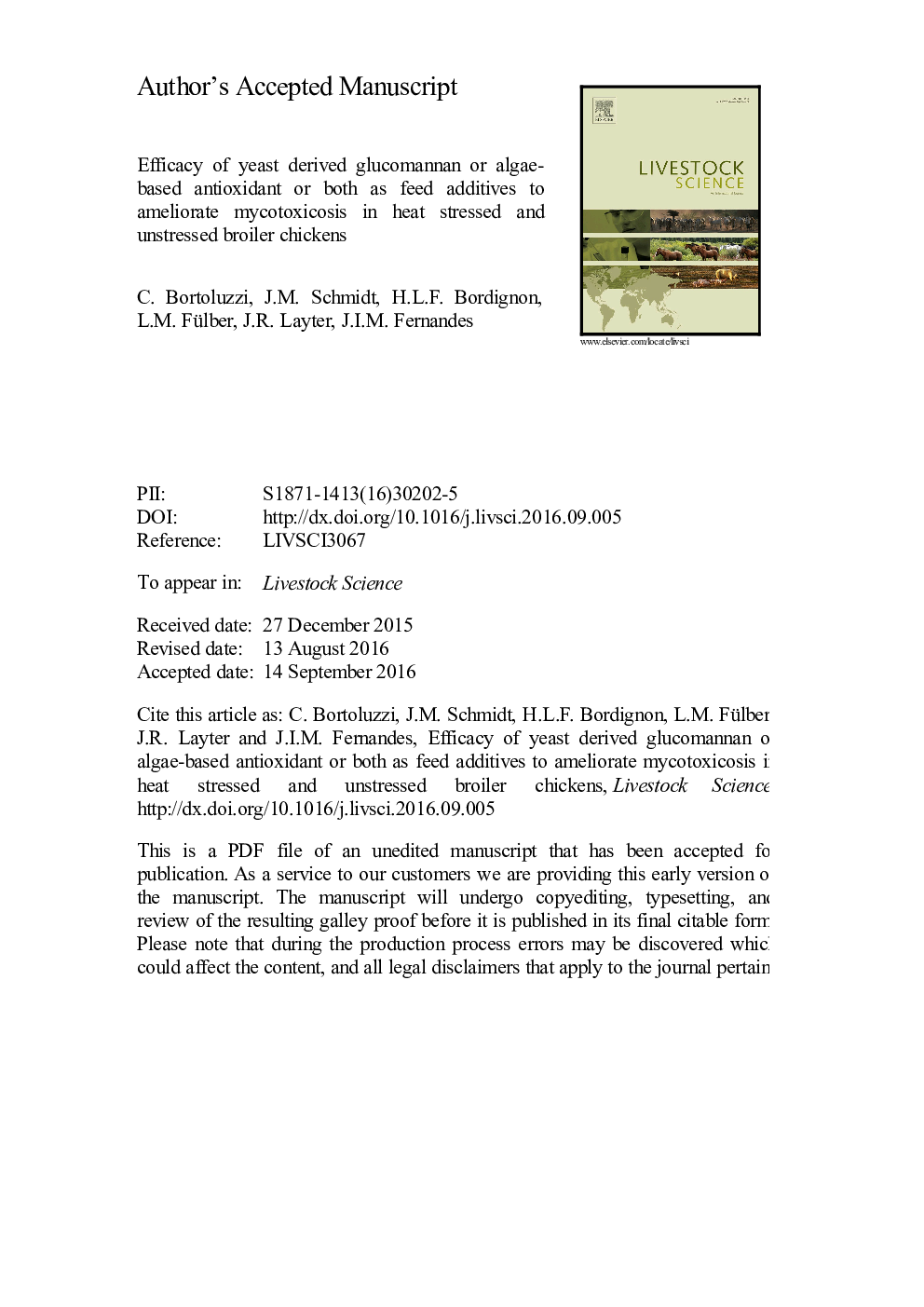| کد مقاله | کد نشریه | سال انتشار | مقاله انگلیسی | نسخه تمام متن |
|---|---|---|---|---|
| 5543043 | 1553939 | 2016 | 17 صفحه PDF | دانلود رایگان |
عنوان انگلیسی مقاله ISI
Efficacy of yeast derived glucomannan or algae-based antioxidant or both as feed additives to ameliorate mycotoxicosis in heat stressed and unstressed broiler chickens
ترجمه فارسی عنوان
اثربخشی آنتی اکسیدان گلوکومنان یا جلبک مشتق شده از مخمر و یا هر دو به عنوان مکمل های خوراکی برای بهبود میکروکسیکوز در جوجه های گوشتی گرم و بدون استرس
دانلود مقاله + سفارش ترجمه
دانلود مقاله ISI انگلیسی
رایگان برای ایرانیان
کلمات کلیدی
میوکوتوکسین ها، جوجه های گوشتی، کیفیت گوشت، آنتی اکسیدان، جاذب،
موضوعات مرتبط
علوم زیستی و بیوفناوری
علوم کشاورزی و بیولوژیک
علوم دامی و جانورشناسی
چکیده انگلیسی
Mycotoxin-contaminated corn may negatively affect the growth performance of broiler chickens, which led the feed industry to adopt strategies that could ameliorate the adverse effects of mycotoxins. The objective of this study was to investigate the effects of the dietary inclusion of an algae-based antioxidant and esterified glucomannan derived from yeast cell wall on broiler chickens affected by mycotoxicosis before and after the exposure to heat stress during the pre-slaughter period. 1225 one-day old broiler chickens were allocated in 5 dietary treatments (7 replicates each): basal diet formulated with corn classified as uncontaminated (control, CON); basal diet formulated with corn naturally contaminated with mycotoxins (contaminated control, CC); CC+esterified glucomannan; CC+algae based-antioxidant; and CC+esterified glucomannan+algae based-antioxidant. From 42 to 44 d of age all of the remaining broiler chickens were subjected to pre-slaughter heat stress (48 h at 32 °C). The feed formulation with contaminated corn impaired the feed conversion ratio (FCR) from 0 to 42 d of age (P<0.05), but the supplementation with antioxidant partially improved the FCR. The mycotoxins itself decreased the b* value of the meat (P<0.05), which may negatively be affected by other factors, such as pre-slaughter heat stress. High ambient temperature during the pre-slaughter period decreased the water loss after cooking, increased the thiobarbituric acid reactive substances value, and decreased the pH value of the meat in all the times evaluated (0, 6, 12, and 18 h after slaughter, P<0.05). In conclusion, the classification of the corn was an effective strategy to reduce its amount of toxins, and the antioxidant supplementation partially improved the FCR in contaminated corn-fed broiler chickens.
ناشر
Database: Elsevier - ScienceDirect (ساینس دایرکت)
Journal: Livestock Science - Volume 193, November 2016, Pages 20-25
Journal: Livestock Science - Volume 193, November 2016, Pages 20-25
نویسندگان
C. Bortoluzzi, J.M. Schmidt, H.L.F. Bordignon, L.M. Fülber, J.R. Layter, J.I.M. Fernandes,
